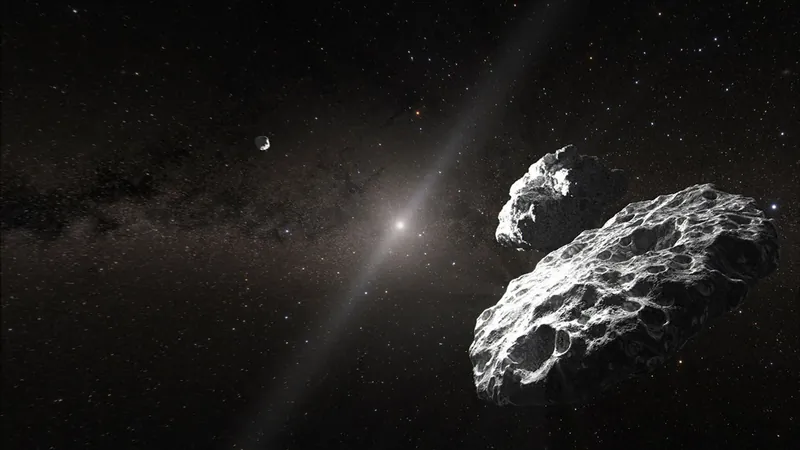
Hubble Discovers Rare Triple System in the Kuiper Belt
2025-05-17
Author: Rajesh
A Cosmic Breakthrough Beyond Neptune
A groundbreaking revelation has emerged from the depths of our solar system. NASA researchers have unearthed evidence of a rare and complex trio of icy bodies orbiting each other in the mysterious Kuiper Belt—a vast region beyond Neptune filled with remnants from the formation of our solar system.
Meet Altjira: The Star of the Discovery
At the heart of this discovery is a celestial object named (148780) Altjira. Advanced imaging techniques and extensive data analysis indicate that Altjira is not just a single entity but a hierarchical triple system. This means two objects are locked in a close orbit, with a third body circling them from a greater distance—a configuration rarely seen in this remote expanse.
What Makes a Hierarchical Triple System So Unique?
While many icy bodies beyond Neptune are found in binary pairs, Altjira's triple formation is a fascinating anomaly. It showcases a delicate cosmic ballet where all three bodies exert gravitational influences on one another. Such systems are difficult to identify, but they can offer profound insights into the evolutionary history of our solar system.
The Search for Cosmic Companions
Finding a triple system like Altjira isn’t a walk in the park. It required years of meticulous data collection and cutting-edge telescopes, including the Hubble Space Telescope and the W. M. Keck Observatory in Hawaii. These instruments enabled researchers to sift through 17 years' worth of observations to piece together this cosmic puzzle.
Behind the Data: A New Understanding
To analyze the gathered data effectively, scientists utilized a new open-source tool called nPSF. This technology optimizes the measurement of light spread in telescope images, allowing researchers to uncover the unusual movement patterns of Altjira’s components. This meticulous tracking revealed shifts in the orbital dynamics that suggested the presence of a hidden third object.
A Glimpse Back in Time
This remarkable finding doesn't only expand our understanding of Altjira; it may also transform our concept of the Kuiper Belt as a whole. Scientists consider the Kuiper Belt objects, like Altjira, as ancient relics from the solar system’s inception, formed approximately 4.5 billion years ago. Having discovered over 3,000 Kuiper Belt Objects (KBOs), researchers now question the origins of these icy bodies.
Reevaluating Formation Theories
Historically, scientists believed KBOs typically formed through random collisions leading to binary structures. However, the evidence from Altjira supports a theory suggesting that these triple systems formed from gravitational collapses of gas and dust clusters in space, akin to star formation.
Connecting to Arrokoth
Interestingly, Altjira is a relative of another KBO, Arrokoth, which was investigated by NASA's New Horizons spacecraft in 2019. While Arrokoth is a contact binary, Altjira stands out at approximately 124 miles (200 kilometers) across and offers its own unique attributes.
A Golden Opportunity in Astronomy
Currently, Altjira is in an 'eclipsing season' where its outer body obscures the central pair, a phenomenon set to continue until around 2030. This rare alignment provides astronomers with invaluable opportunities to gather additional data.
What Lies Ahead?
The future of studying Altjira looks bright. With the James Webb Space Telescope gearing up to observe the system, scientists are eager to learn how each component reflects light, potentially unlocking more secrets about their structures and compositions.
Expanding the Universe of Knowledge
As researchers delve deeper into Altjira's patterns and gravitational signals, they are challenging traditional models. Unlike simpler point-mass objects, Altjira showcases complex motion patterns that hint at an intricate inner structure. This could lead to better predictive models, enhancing our understanding of celestial movements.
This exciting discovery emphasizes the ongoing potential of advances in astronomical technology and long-term observational strategies. With each new finding, the enigmatic Kuiper Belt reveals more about the ancient icy worlds that shaped our solar system.
Stay Tuned for More Discoveries!
This discovery, recently published in The Planetary Science Journal, reinforces the importance of collaboration between observational data, modeling, and cutting-edge technology in unravelling the mysteries of our cosmic neighborhood.





 Brasil (PT)
Brasil (PT)
 Canada (EN)
Canada (EN)
 Chile (ES)
Chile (ES)
 Česko (CS)
Česko (CS)
 대한민국 (KO)
대한민국 (KO)
 España (ES)
España (ES)
 France (FR)
France (FR)
 Hong Kong (EN)
Hong Kong (EN)
 Italia (IT)
Italia (IT)
 日本 (JA)
日本 (JA)
 Magyarország (HU)
Magyarország (HU)
 Norge (NO)
Norge (NO)
 Polska (PL)
Polska (PL)
 Schweiz (DE)
Schweiz (DE)
 Singapore (EN)
Singapore (EN)
 Sverige (SV)
Sverige (SV)
 Suomi (FI)
Suomi (FI)
 Türkiye (TR)
Türkiye (TR)
 الإمارات العربية المتحدة (AR)
الإمارات العربية المتحدة (AR)